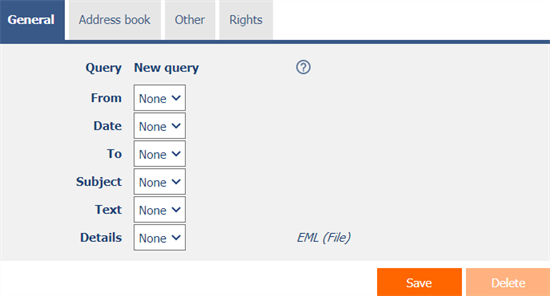Manual in PDF format
1. Basic information
1.1. Description of the control
Email a simple e-mail client for inbox that displays (but does not download or store to the database) incoming e-mail messages from a POP3 or IMAP mail server.
1.2. Create a new control
A new email can be created as follows from the preview page using the toolbar with controls:
- First, clicking on the view page determines the position in which the new email should be placed. This will highlight the selected position with a gray horizontal line. Then just click on “E-Mail” in the toolbar of the view page, fill in the attributes of the new control in the newly opened dialog, and then save. This will insert a new email at a pre-selected location on the view page.
- If the desired position is not determined before entering a new email, the new email will be inserted at the end of the view page.
1.3. Edit or delete a control
- For each existing control, a pencil icon appears to the left of the control page to change or delete the control's settings.
- Individual controls can be moved vertically on the view page using the Drag&Drop method. Moving consists of grabbing the control, preferably behind its name, and then dragging it to the desired location on the view page.
- For security reasons, it is important to have the function of moving controls enabled using the “Drag&Drop” check box located above the toolbar with controls. This field is unchecked each time you log in to the application.
2. List of tabs in the control settings dialog
- General – Setting general properties
- Address book – Directory settings
- Other – Setting other properties
- Rights – Rights settings
- Administration – Setting other properties
2.1. “General” tab

2.1.1. Query
- The query defines a database table that is used to store outgoing e-mail messages.
- The query is used by the form for entering a new e-mail message, which is accessible via the “New e-mail message” view pages. A detailed description of the preview page settings is given in the separate “Preview page” manual.
2.1.2. From
- Select a column that identifies the sender of the outgoing e-mail message.
2.1.3. Date
- Select a column that specifies the date the outgoing e-mail message was sent.
2.1.4. To
- Select a column that identifies the recipient of the outgoing e-mail message.
2.1.5. Subject
- Select a column that specifies the subject of the outgoing e-mail message.
2.1.6. Text
- Select a column that specifies the text of the outgoing e-mail message.
2.1.7. Details
- Select the column in which to store the source code of the outgoing e-mail message in “eml” format.
2.2. “Address Book” tab


2.2.1. Type
- Default – The database table in the “Email” application will be used to store contacts. This application can be imported from the “NETGenium\Install” directory.
- Own – The own database table defined in the “Data source” field will be used for storing contacts.
2.2.2. Data source
- The data source defines the source database records of the directory contacts.
- Data source settings are made in the graphical designer of database queries. A detailed description of the database query designer is provided in the separate “Database Query Designer” guide.
2.2.3. Name
- Select a column that specifies the name of the contact.
2.2.4. E-mail address
- Select a column that specifies the contact's e-mail address.
2.2.5. Help
- Select the columns that appear in the address book pickup along with the contact's name and e-mail address.
2.3. “Other” tab

2.3.1. Options
- Show the Time Span toolbar
- Checking this box determines whether the controls for selecting the time period of the date the incoming e-mail message was sent should be displayed above the incoming message view table.
- Show tooltip
- Checking this box determines whether the view table with incoming messages should display the details of individual records in the tooltip when the mouse hovers over individual records.
2.4. “Rights” tab

2.4.1. Rights
- Rights define a list of user groups and users who have permission to display the control on the view page.
2.4.2. Replace rights to other controls
- The “Replace rights to other controls” feature is used to unify rights across the entire view page for controls that are related in terms of rights.
- Thanks to the “Show…” link, it is possible to display a list of all controls on the view page, including the settings of the rights of these controls. For each control, a check box is displayed that allows you to select the control. When you save a control, the same rights are then set for those selected controls.
- An alternative for unifying rights within the entire view page is to display the report available from the “Subordinate object rights” tab in the view page settings.
2.5. “Administration” tab

- The “Administration” tab is only displayed for existing controls.
2.5.1. Location
- Select the view page on which the control is located.
- The drop-down list contains all view pages located in the same application.
